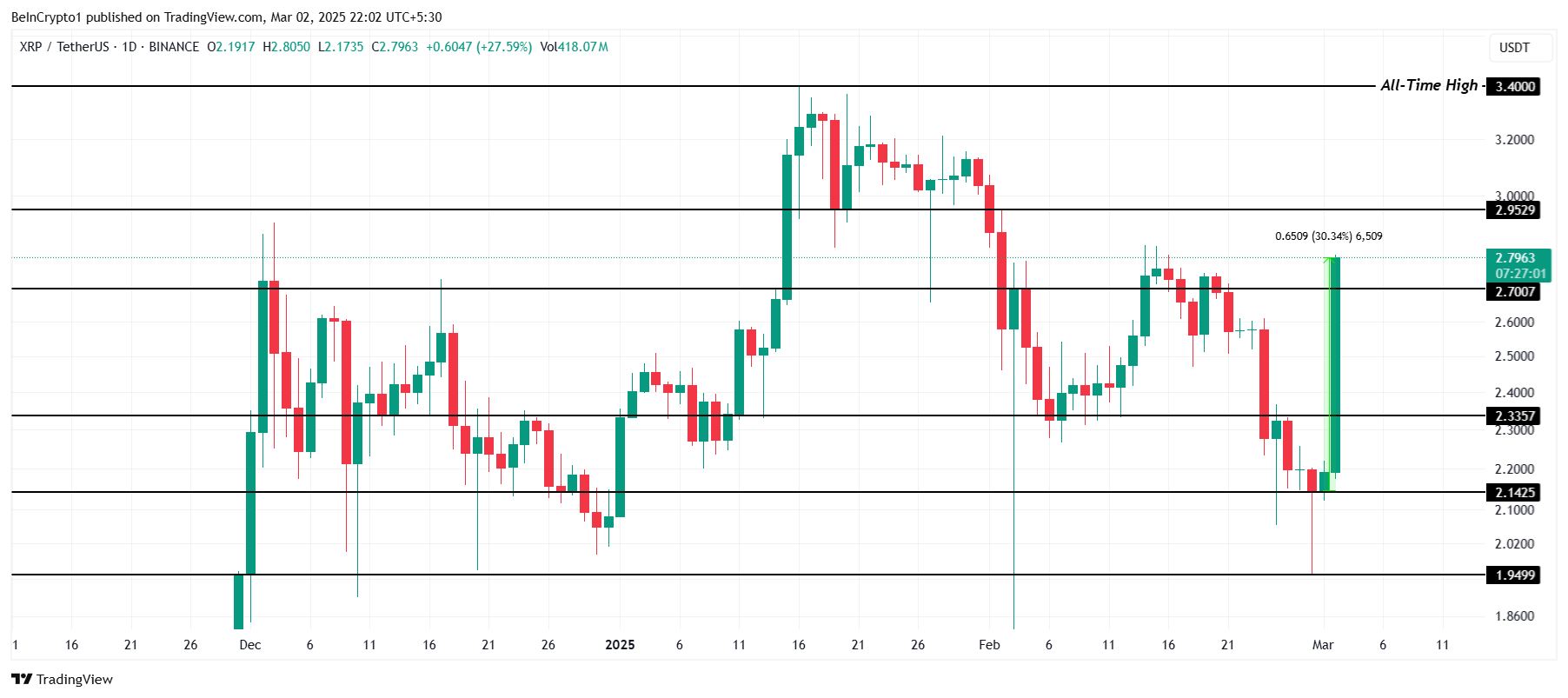Bitcoin returns to the $100,000 mark, is market sentiment reversing again?
The core CPI data in the U.S. unexpectedly fell, and Trump's administration along with SEC regulatory reforms boosted a reversal in market pessimism.
Author: 1912212.eth, Foresight News
Since November 7, Bitcoin has been on a downward trend, even briefly falling below the $90,000 mark, leading to widespread lament in the market. A series of macroeconomic negative factors have led the market to accept a psychological expectation that it could drop to around $85,000. Interestingly, Bitcoin eventually stabilized above $89,000 and then rebounded, surging after the CPI data was released yesterday. In the early hours of January 16, BTC once again broke through the $100,000 mark.
Ethereum, after dropping below $3,000, has been rising steadily, reaching above $3,400 this morning. SOL also broke through $200 this morning after falling below $170. The altcoin market is experiencing a revival, with some altcoins rising between 5%-8% in the last 24 hours. The AI sector is rebounding rapidly, with LMT hitting a new all-time high, and AIXBT even surpassing $0.9, setting a new historical peak.
In terms of contract data, Coinglass data shows that the total liquidation across the network in the last 24 hours was $349 million, with $221 million in short liquidations. The largest single liquidation occurred on Binance, valued at $12.6 million for the ETH/BTC contract.
Recently, MicroStrategy founder Michael Saylor has posted for the tenth consecutive week, asking, "Is there a green dot missing from the MicroStrategy portfolio tracking chart?" suggesting that he will continue to increase his Bitcoin holdings. At the Benchmark investor conference held in Orlando, Michael Saylor stated that the perpetual preferred stock the company may issue would be "the latest means to provide investors with leveraged Bitcoin investments." He pointed out that the company's goal is to provide investors with "returns and volatility equivalent to 1.5 times Bitcoin." Michael Saylor's steadfast buying actions and determination have undoubtedly alleviated some of the selling pressure in the market.
The market suddenly swept away pessimism, and the market warmed up. What is the real reason behind this?
U.S. Core CPI Data Unexpectedly Declines, Slight Increase in Probability of Rate Cut in March
Last night, the U.S. December unadjusted CPI year-on-year rose to 2.9%, marking the third consecutive month of rebound and reaching a new high since July 2024, in line with market expectations, with the previous value being 2.7%. Additionally, the U.S. December unadjusted core CPI year-on-year recorded 3.2%, the lowest since August 2024, with market expectations remaining flat at 3.3%.
After the CPI data was released, the three major U.S. stock index futures surged sharply, with Nasdaq futures up 1.52%, SP 500 futures up 1.31%, and Dow futures up 1.26%. The yield on U.S. two-year Treasury bonds further declined, dropping 6.5 basis points to 4.299%.
Before the CPI data was released, the probability of the Federal Reserve maintaining interest rates in January was 97.3%, while the probability of a 25 basis point rate cut was 2.7%. The probability of maintaining the current rate in March was 79.8%. After the data was released, the probability of a 25 basis point rate cut in March slightly increased to 28.2%, up from 23.2% the previous day. However, the probability of not cutting rates in March remains as high as 71%.
Nick Timiraos, a veteran reporter known as the "new Fed correspondent," believes that robust employment data, coupled with mixed signals of inflation improvement, has led Fed officials to indicate that they are still prepared to hold steady in January until they see more evidence that current interest rates can effectively curb inflation.
Tina Adatia from Goldman Sachs Asset Management stated that while the latest CPI data may not be sufficient to make a rate cut in January possible again, it reinforces the view that the Fed's rate-cutting cycle has not yet ended.
Ellen Zentner from Morgan Stanley Wealth Management also believes that Wednesday's CPI data will not change expectations for a pause in rate hikes at the end of this month, but it should suppress some discussions about the Fed potentially raising rates.
After the market's concerns about the CPI data subsided, capital inflow into the crypto market resumed. Data from Trader T and Farside Investors showed that yesterday, the U.S. Bitcoin spot ETF saw a net inflow of $754.79 million, reversing a five-day streak of net outflows. The Ethereum spot ETF had a net inflow of $59.12 million, injecting optimism back into Ethereum.
Trump Set to Take Office, SEC Expected to Reform Policies
Trump is just four days away from officially taking office. The market is eagerly anticipating his new actions after taking office. As early as January 9, Reuters cited insiders reporting that the industry expects at least one order to be issued on January 20.

Trader Ansem previously stated that the uncertainty and fear in the market may dissipate after Trump's inauguration, depending on his remarks.
On January 16, Reuters also reported that Trump's SEC team is reviewing several pending crypto enforcement cases in court and is expected to comprehensively reform crypto policies, possibly freezing some lawsuits that do not involve fraud allegations. Three insiders indicated that Republican officials at the SEC are prepared to begin reforming the agency's cryptocurrency policies as early as next week after Trump takes office.
Among the measures being considered by commissioners Hester Peirce and Mark Uyeda include initiating relevant procedures to ultimately formulate guidelines or rules that clarify under what circumstances the agency will consider cryptocurrencies as securities, and reviewing some cryptocurrency enforcement cases currently in court.
As a result of this news, some projects entangled with the SEC, such as XRP, saw a rise of over 17% on the same day.
Trump's ascension to power and SEC regulatory reforms are helping to reverse the market's pessimistic sentiment.
Summary
The future trend of the market is of great concern to investors. Placeholder partner Chris recently tweeted that under a supportive U.S. policy environment, the crypto market may not see parabolic surges in returns in the coming years, but rather more stable growth, with pullbacks in mainstream coins potentially becoming less extreme. Large pullbacks of 85%-95% typically occur when the market structure has accumulated too much unrealized profit, and the market fears that these assets may never rise again. Now, the world is gradually recognizing that Bitcoin and quality crypto assets will exist in the long term, so the "death pricing" experienced by mainstream coins may be a thing of the past (excluding certain meme coins).
Additionally, Chris believes that the launch of ETFs for both BTC and ETH (and possibly soon for SOL as well) will bring more stable buying pressure for these assets. If you want to understand the potential pullback BTC may face, you can observe the 200-week simple moving average (200W SMA), which is the most reliable technical support during each bear market. Currently, this moving average is around $40,000, indicating that a 60% pullback may occur in a bear market. Chris still believes that 2025 will be a year full of volatility and opportunities.
The crypto market is significantly influenced by macroeconomic and policy factors, and substantial fluctuations often occur at important market event nodes. Investors should pay attention to risk control.
Disclaimer: The content of this article solely reflects the author's opinion and does not represent the platform in any capacity. This article is not intended to serve as a reference for making investment decisions.
You may also like
Biggest CME gap ever at $85K: 5 things to know in Bitcoin this week
Bitcoin enjoys a major "Trump pump," but traders warn that fresh BTC price support retests are still a risk ahead of this week’s key White House crypto summit.

Bitget Daily Digest (March 3) | Trump promotes $XRP, $SOL, $ADA on social media, Whale trades spark market attention
The crypto market rallied as investors digested news of U.S. President Donald Trump’s plan to establish a crypto reserve. An analyst from Presto Research said market expectations “may remain high” until Friday, given that White House Crypto Czar David Sacks teased “more to come” at the Crypto Summit set to take place on Friday.

Cardano (ADA) Shows Potential for Further Gains as Price Approaches Key Resistance Level

XRP Eyes Potential Growth as Investor Confidence Rises After Trump’s Crypto Reserve Announcement

